Tag Archive: teaching
October 14, 2016
by Carole Zangari -

One of the best ways to enhance our teaching is to understand and respect the things that motivate our learners. We are all motivated by different things, though, and sometimes it can be hard to figure out the specifics of what a particular learner likes well enough for it to be used as reinforcement. Sometimes it’s easy. We all know kids who would do anything for [iPad time; Thomas the Tank Engine, Super Why, Pokemon, Hello Kitty] or [you fill in the blank]. We can use those in formal and informal ways to keep these learners motivated and engaged. And that’s important because, often, what we are asking them to do is hard. But sometimes, we work with people for whom those ‘magic motivators’ aren’t so clear. The ‘typical’ reinforcers don’t seem to work for those folks, and that can slow down progress. How can we figure out what motivates... [Read More...]
Filed under: Featured Posts, PrAACtical Thinking
Tagged With: forms, preferences, reinforcement, teaching
April 4, 2016
by Carole Zangari -
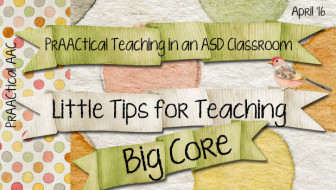
Special educators Lauren Pawlowski and Amy Devin are back with tips for making AAC work in the classroom. In their first post, they talked about using a large communication board that is rich in core vocabulary for aided language input and AAC instruction. Today, they share some of the things they’ve learned to make this more manageable in a busy classroom. Enjoy! ::::::::::::::::::::::::::::::::::::::::::::::::::::::::::::::::::::::::::::::::::::::::: We hope that many of you were able to make your Big Core boards for group instruction. Now what?? Using Big Core can take a while to get used to. Even after using it for several years, sometimes we still struggle with finding the words quickly. Don’t worry about this because our students can’t always find words quickly and it is good for them to see that everyone struggles with language at times. It can also be empowering to them if you ask for their help! The... [Read More...]
Filed under: Featured Posts, PrAACtical Thinking
Tagged With: classroom, core, education, teaching
December 22, 2013
by Robin Parker -

Awesome video from Kreed’s World on teaching short conversations. Look at the great example of the language facilitation strategy: repetition with variety. Also, look at the meaningful language experience for Kreed (and his communication partner) as the conversation was authentic and based on Kreed’s interest.
Filed under: Video of the Week
Tagged With: Conversation, meaningful language experience, repetition with variety, teaching
October 17, 2013
by Robin Parker -
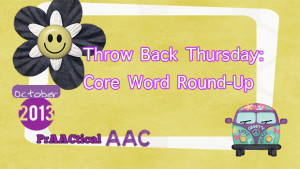
Core Word Round-up! Core Word PrAACtice Ideas Magic Moments: AAC Intervention with Stop and Go App Magic Moments with Toca Store Magic Moments with Sentence Builder Magic Moments with Verb Circus HiJAACked! Putting an AAC Twist on Gen Ed AACtivities: The Hallelujah Flight AAC Goes to PreSchool 5 PrAACtical Uses for Flashcard Apps Visual Language, Core Words, & Martin Luther King Can I Ask You A Question? Breakthroughs with Bubbles with Tanna Neufeld 14 Valentine’s Day Activities, Love, Literacy, & Learning AAC Learning with Play Dough by Jamie Cooley 5 Ways to Use Power Point in AAC Intervention 5 PrAACtical Thoughts on Catch-Up Conversations How I do It- Marlene Cummings Shares an Implementation Toolbox AACtual Theray with Tanna Neufeld- Use Your Best Spud To Teach Vocabulary How I Do It- Marlene Cummings On Strengthening the Communication... [Read More...]
Filed under: PrAACtical Thinking
Tagged With: resources, teaching
September 3, 2013
by Carole Zangari -
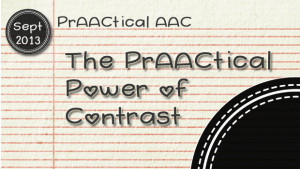
It’s a(nother) new semester for us and that means we get the chance to work with a whole new crop of graduate student SLPs who are learning to provide AAC services for the very first time. It just doesn’t get any better than that! One of the challenges for all beginning clinicians is deciding what intervention strategies to use to facilitate their clients’ learning in various areas. Recently, I had a wonderful conversation about the power of contrastive examples. I was taught this strategy by Dr. Ed Kame’enui and still use his ‘glerm’ activity today to illustrate the concept. The ‘glerm’ activity was quick way to demonstrate how to use carefully chosen examples to teach a new concept. Here’s the activity. You have to use your imagination and pretend this is a demonstration rather than a paper-and-pencil activity, but you’ll get the idea. And glerm is….? If I did a good... [Read More...]
Filed under: PrAACtical Thinking
Tagged With: contrast, direct instruction, glerm, teaching
August 14, 2013
by Robin Parker -
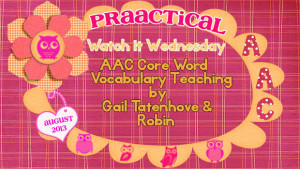
Thanks so much to Gail Tatenhove & Robin for showing us an authentic language based activity with talking and core word teaching/learning as the main focus. You can watch and clearly see the goals and teaching strategies. For more great teaching examples, subscribe to Gail Tatenhove’s You-Tube Channel Direct Link to the Video: https://www.youtube.com/watch?v=q9hZ5rH03ow
Filed under: PrAACtical Thinking
Tagged With: aided language input, by Gail tatenho, examples, teaching
January 19, 2013
by Robin Parker -
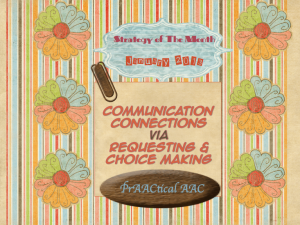
The January Strategy of the Month has focused on requesting and choice making. These are really fun goals to implement. They fall under the communication function that helps us meet our own needs (Behavioral Regulation). When we get what we want, there is a sense of control over the environment & we increase symbolic communication/language, and self-sufficiency. It’s all good. The assumption for all requests and choices is that the learner ‘likes’ what they have asked for. This is what makes the process so much fun, we get to do activities and have interactions that are positive and motivating. If only it was that easy… Sometimes it is not… But do not worry…there are plenty of solutions for common (and not so common) problems when teaching requesting and choice making. As always, set the stage for a positive TEACHING paradigm and then move to problem solving if necessary (and when it is... [Read More...]
Filed under: Strategy of the Month
Tagged With: choice making, preferences, requesting, teaching
January 5, 2013
by Carole Zangari -
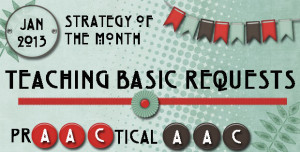
With the start of the new year, we thought it would be a good time to get back to basics. So this month, we’ll talk about the nitty gritty of teaching basic requesting to someone who is first learning to communicate using AAC. For learners who are not sending purposeful communication signals or those who seem unaware that communication involves interaction with another person, we think it makes sense to consider using the PECS curriculum. Why? Because the act of being assisted in physically giving a picture symbol to another person in exchange for a desired object can be an efficient way for someone to gain awareness of two critical principles. First, they learn that communication gives them the power to impact their environment. Secondly, the direct exchange highlights the fact that communication involves two people. As the PECS curriculum is already well established, its procedures will not be addressed... [Read More...]
Filed under: Strategy of the Month
Tagged With: Instruction, language intervention, requesting, teaching
November 20, 2012
by Carole Zangari -
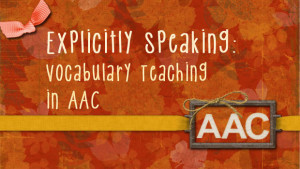
An essential part of the model we shared for AAC semantic intervention is Step 2, teaching the new words with explicit instruction activities. In our posts, explicit instruction refers to the process of designing and using carefully planned sequence of empirically-supported teaching activities. Though focused on reading, not vocabulary, development, this PowerPoint presentation by Dr. Anita Archer gives an excellent overview of the characteristics of explicit instruction. In our initial teaching of new words, we to be sure that the learners have frequent opportunities to respond: Active participation is critical at this point. We have to give the learner a lot of opportunities to say the word (e.g.,“resume”) and tell about it (e.g., “keep going,” “start again and not stop,” “verb”, etc.). We want to elicit a lot of responses so that we can monitor their performance. That allows us to provide feedback that is affirmative when the learners respond... [Read More...]
Filed under: PrAACtical Thinking
Tagged With: implementation ideas, new word learning, semantics, teaching, teaching activities, vocabulary
November 10, 2012
by Robin Parker -
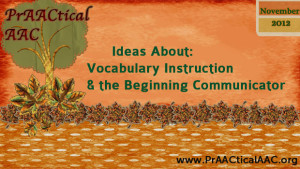
Vocabulary instruction is a topic not often discussed for beginning communicators. As we work with beginning communicators the primary focus is often vocabulary selection for communication displays. This is understandable as the beginning communicator has many needs, but that is no excuse for leaving out vocabulary instruction. Direct vocabulary instruction helps expand broader vocabulary selection options, literacy skills, and world knowledge. With that in mind, see below for vocabulary instruction philosophies, notes, and activities for the beginning communicator. Please let us know about your favorite vocabulary instruction activities. Vocabulary Instruction for the Beginning Communicator: 5 Philosophies Vocabulary instruction involves a systematic TEACHING process. Add vocabulary as an activity on the daily schedule and then have a mini-schedule for the specific vocabulary instruction activities for that day. Carole introduced general steps for vocabulary instruction last week. For the beginning communicator, also apply an errorless learning paradigm. Gradually, add comprehension checks, but... [Read More...]
Filed under: Strategy of the Month
Tagged With: beginning communicator, communication, language, language facilitation activities, teaching, vocabulary









